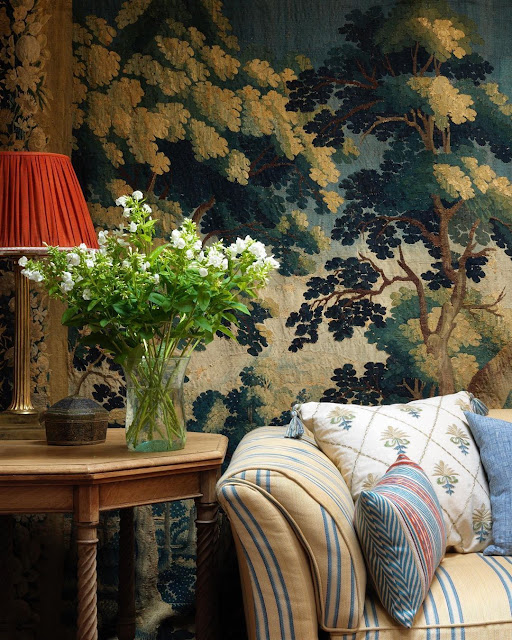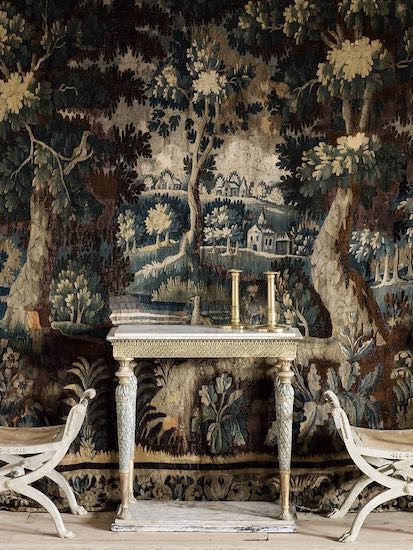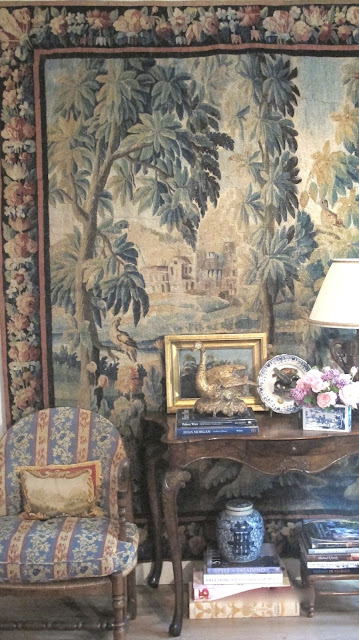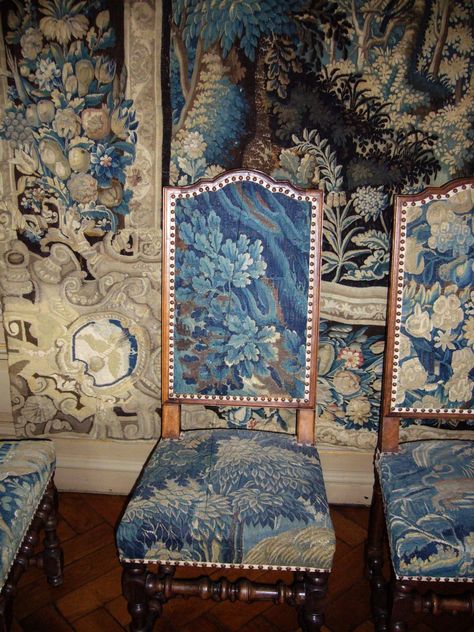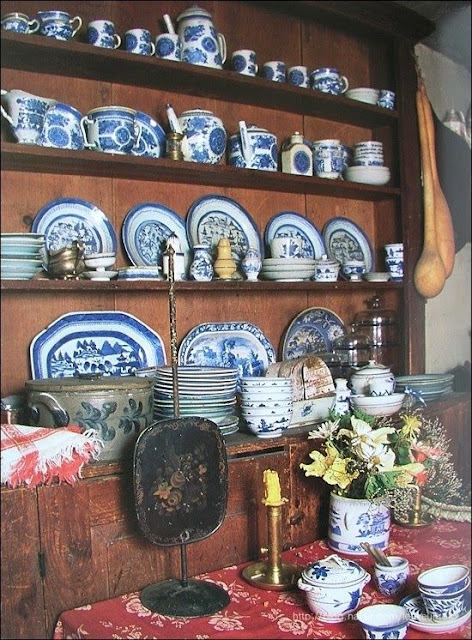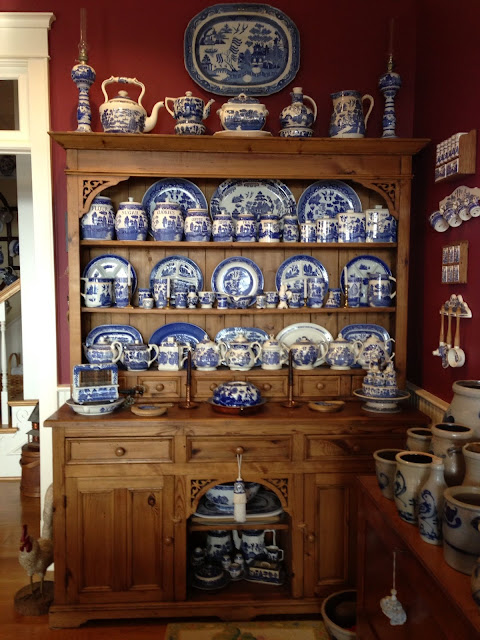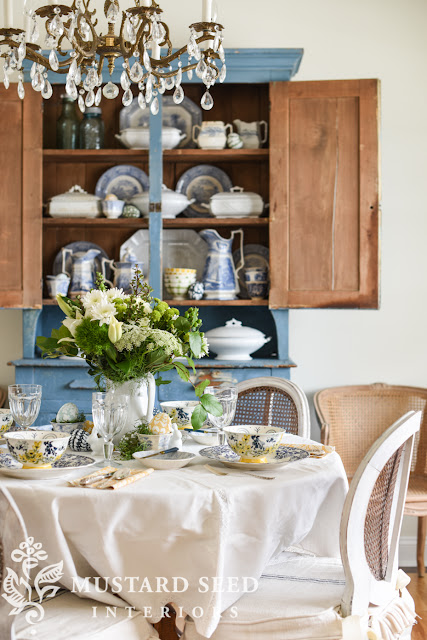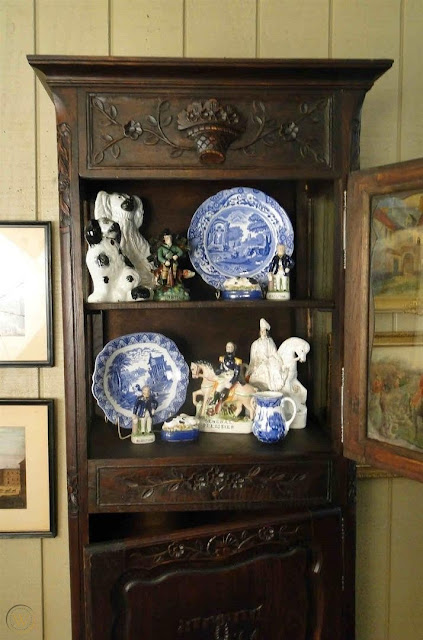Tapestries were used in the Middle Ages as much for insulation in drafty castles and châteaux as for entertainment and decoration. The warmth they provided on walls and around canopies was desperately needed. In the old world however utilitarian necessities were still created with aesthetics in mind.....and aren't we glad!! This particular post has been created to draw attention to my favorite style of tapestry, the Verdure Tapestry.
Hunting was very popular with the aristocracy in Europe in the 1500 and 1600's and these hunting scenes in the forests were the inspiration for creation of the lush green landscapes or “verdure” (from old French word vert, for “green”) tapestries of the time. It was under Louis XIV's reign that Les Gobelins factory was founded in Paris as well as other such famous tapestry factories as Aubusson and Lille that were renowned for their production of Verdures.
Also in 1619 James I of England decided that tapestries should not be solely a French decorating element. He began promoting the Mortlake Tapestry Factory on the Thames which had earlier been established by Sir Francis Crane. Now England could also create beautiful Verdure tapestries for the royal courts.
The chief features of the Verdures were the large wooded landscapes and flowing all-over patterns of lush trees and vegetation in shades of beige, green, brown and blue. These tapestries were immensely popular. In the last half of the 17th century, landscapes were incorporated into their design that featured rivers, bridges castles, and châteaux.
In recent years verdure tapestries have experienced a revival and are being produced by weavers in France and Belgium in a wide range of sizes. There are many beautiful tapestries to choose from that have flora, fauna, and scenic vistas as their theme. A gorgeous Verdure tapestry will instantly create an old world feel to your space as well as a sense of warmth and charm.
Robert Kime
It is not entirely certain where verdure tapestries were first produced. However by the sixteenth century, this tapestry was recognized as an art form. Because of the timeless appeal of their natural and peaceful settings the French Verdure tapestry provides the perfect backdrop.
The term “verdure” is derived from the French “vert”, translated as “green”, reflecting the lush greenery common to them. Forests, woodlands, and thick green vegetation, sets the scene for these wonderful tapestries. I love the way a Verdure beckons you to gaze through the trees at the landscape beyond.
A seventeenth-century Verdure tapestry hangs behind a terracotta bust of Madame du Barry. Verdures were also called garden tapestries and were trendy with European royalty and nobility.
via Pinterest
For a soothing piece of art Verdure tapestries are hard to beat, provided that the style fits within the setting of your home.
Lisa Farmer-Eye For Design
This image is from my living room where I have a Verdure tapestry I bought at auction called The Forest of Clairmarais. This tapestry was originally produced in Flanders in the early 17th century and now is superbly woven in France. It is an heirloom piece and a classic Verdure tapestry that provides a natural, partly forested setting of large trees, plants, water and hills.
Lisa Farmer-Designs
I also have a Verdure that I use as a rug in my office. No matter where you put them they seem to take command.
I adore how these medieval Verdure tapestries bring a romantic spirit of the old world to an interior.
Here is a Verdure tapestry with a lush green forest scene. The tall tress with its impressive foliage in a variety of hues can be seen, with a river flowing and a bridge in the distance. A castle sits on the hill above.
One of the most distinctive types of tapestry weavings produced in Flanders at this time were the Verdures of Oudenaarde. This is a type of tapestry that incorporates design elements based on plant forms and that typically features a scenic garden or countryside landscape setting surrounded by a border of fruits and flowers
Alidad LTD
Here a Verdure tapestry takes center stage and everything else in the room becomes part of the supporting cast.
In Sissinghurst Castle a Verdure tapestry is in keeping with the Rococo and Romantic style of landscapes with deep thick foliage, the aristocracy enjoying nature, and pictures of wildlife and birds like swans you see here. Castles and gardens were also often depicted.
The Verdure hangings were immensely popular with those customers who could afford such luxury because of the way they impressively brought nature into the home. Verdures, like this one, also created a sense of space in an interior due to the depth of their scenes.
Birr Castle, Ireland via Pinterest
Verdure tapestries could be compared to landscape-paintings. Unlike Italian painting of the time, there were no religious or mythological scenes, only nature with occasionally a few animals and people and buildings in the background.
Perhaps its the soothing effect of the natural shapes and colors that makes vistas of landscapes the preferred view for most people. The Verdure tapestry provides a sense of actually walking right into one of these scenes.
Nicholas Haslam Ltd
In this lovely Verdure tapestry a little dog is barking at some water fowl in a stream in this scenic landscape with an ancient town in the background. The main focus however, is the large leaves and thick foliage that fills the foreground.
veranda.com
The freshness and beauty of nature brings something special into our homes. That is why Verdure tapestries are sought after by collectors today.
Hatfield House (childhood home of Queen Elizabeth I)
Verdure tapestries were many times thought of as "wallpaper" of sorts and pictures were hung on them.
A fabulous hand woven tapestry with a very beautiful design of greenery. Of you are a blue transferware collector notice how beautifully a Verdure tapestry sets these pieces off.
Tapestries were often thought of as movable frescos.
Entrances are ideal places to hang a Verdure tapestry to help bring the outside in!
via Pinterest
This lovely tapestry shows the hallmarks of the Verdures such as leaves and foliage on the forest floor as well as the on the trees. Plus there is the wildlife darting in and out of the landscape.
Timothy Corrigan
It is easy to see how a Verdure tapestry creates a sense of charm, wonder, and depth to any interior design.
For centuries verdure tapestries remained highly popular and were made on a large scale for export. That was until the arrival of wallpaper which served as a more economical way to decorate a room.
Mercer House, Savanah GA via Pinterest
Wallpaper, however, cannot match the way that a stunning Verdure tapestry can change a room by creating an old world ambiance.
via Pinterest
Verdure tapestries fit in perfectly with the interest in botanical themes during the Renaissance.
Linda Keenan
Of course French chairs covered in Verdure tapestry are irresistible!
via Pinterest
via Pinterest
I am especially drawn to French Verdure tapestries so it's not surprising that this canape upholstered in Verdure leaves me breathless.
French Walnut Louis XV Canapé Covered in 17th Century French Verdure Tapestry.
google.com
Verdure fabric works particularly well with French and English interiors.
via Pinterest
You can even find pillows made from Verdure tapestry fragments to help give an old world look to your space.
Look at this sensational Verdure tapestry room divider!!
I can't say enough about this gorgeous Verdure tapestry headboard.....except SWEET DREAMS!
Paolo Moschino
When you see one of these large tapestries, it’s like walking right into a Verdure fantasy scene.
John Oetgen
A Verdure tapestry will create a sense of charm and wonder in your home and will elevate it's style.
For our homes in today’s time, or palaces in the 17th century, the beauty of the outdoors cannot be beaten.
Michael Taylor
The foliage and trees at the left and right edges creates an allée through which the viewer can see a country château and its grounds.
They look simply marvelous in modern interiors as well.
The Verdure tapestry can certainly change a room by creating a striking and impressive focal point. Plus don't forget the investment value that will be passed down to future generations.
Click here to see the previous post
This blog post was published by Lisa Farmer
In the event that I have not credited the correct source of an image, please contact me at lisafarmerdesigns46@yahoo.com and I would be glad to correct it.

